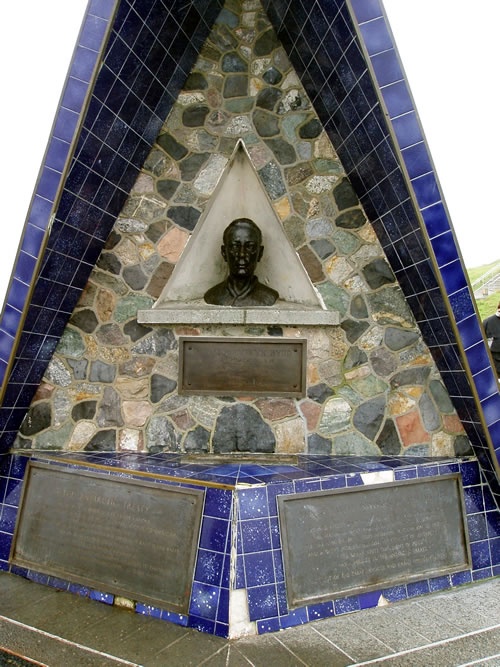
Memorial to Richard E. Byrd on Mt Victoria, Wellington.
Memorials to Richard Byrd in New Zealand
Two memorials have been erected in New Zealand to American polar explorer and aviator Richard Byrd. He used New Zealand as a base for his Antarctic expeditions for 27 years and came to regard the country as his second home.
Mt Victoria, Wellington
The first memorial was erected in Wellington, which Byrd had made his New Zealand base during his second Antarctic expedition (BAE2). He also visited the city during each of the expeditions he led under the auspices of the United States government.
The idea for the memorial came from A. Leigh Hunt, a great friend and admirer of Byrd's. He secured a suitable site at the summit of Mt Victoria and worked on the design of the memorial. But he suffered a stroke and the actual establishment of the memorial was taken on by a committee of citizens chaired by Tracey Simpson.
The memorial, officially named the New Zealand National Memorial to Rear Admiral Richard E. Byrd, was unveiled on 11 March 1962, the fifth anniversary of Byrd's death. Those gathered at the unveiling included the Prime Minister Keith Holyoake, Leader of the Opposition Walter Nash, Mayor Frank Kitts, and Byrd's daughter, Mrs Robert Breyer.
In addition to speeches made by these and other dignitaries, Tracey Simpson read cables of goodwill from other nations. Among these was one from President John F. Kennedy, who stated that the memorial would stand:
As a symbol of enduring friendship between the United States, land of his birth, and New Zealand, the country with which he was so closely associated in his great adventures.
The memorial still stands below the lookout on Mt Victoria. It consists of a monument in the form of a polar tent, the front of which is built up with rocks from Antarctica. The sides were originally covered in white stucco but were reclad in the early 1990s with ceramic tiles depicting auroras, designed by artist Doreen Blumhardt. At the centre of the monument is a bronze bust of Byrd made by Thomas V. Johnston. Byrd faces out of the polar tent towards the sea and Antarctica. Underneath the bust are three plaques which commemorate his achievements. The original plaques were damaged or removed and were replaced during the restoration of the memorial in the early 1990s. Another plaque was added noting the rededication of the memorial on 21 June 1993. It also commemorates Paul Siple, another Antarctic explorer who served in all of Byrd's expeditions.
Unity Park, Dunedin
Another memorial was erected in Dunedin, which Byrd had used as his New Zealand base during his first Antarctic expedition (BAE1). He also visited that city during the United States Antarctic Service Expedition (1939-41).
This memorial was unveiled on 31 October 1967 by the US Ambassador to New Zealand, John F. Henning. The memorial stands overlooking the port of Dunedin in Unity Park, Mornington. It consists of a bust of Byrd upon a half-ton black-granite base. Like the Wellington memorial it contains a bronze plaque commemorating Byrd's achievements. The bust was given to the city of Dunedin by the US National Geographic Society. It is a partial copy of a full-length statue on the ‘Avenue of Heroes' in Washington DC.
Further information
Book
- A. Leigh Hunt, My second home: Admiral Byrd & New Zealand, A Hunt, Wellington, 1968
Links
- New Zealand Memorial to Admiral Byrd (southpolestation.com)
- Dunedin dedicates memorial to Admiral Byrd (southpolestation.com)
- Paul Siple (Wikipedia)
- Paul A. Siple (south-pole.com)




Community contributions